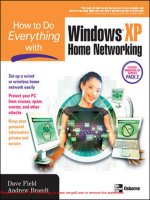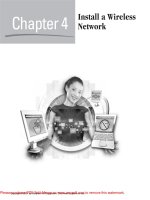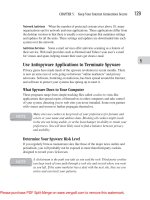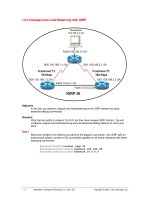Tài liệu Windows 8 Application Development with HTML5 docx
Bạn đang xem bản rút gọn của tài liệu. Xem và tải ngay bản đầy đủ của tài liệu tại đây (29.68 MB, 387 trang )
www.it-ebooks.info
www.it-ebooks.info
Windows
®
8
Application
Development
with HTML5
FOR
DUMmIES
‰
www.it-ebooks.info
www.it-ebooks.info
by Bill Sempf
Windows
®
8
Application
Development
with HTML5
FOR
DUMmIES
‰
www.it-ebooks.info
Windows
®
8 Application Development with HTML5 For Dummies
®
Published by
John Wiley & Sons, Inc.
111 River Street
Hoboken, NJ 07030-5774
www.wiley.com
Copyright © 2013 by John Wiley & Sons, Inc., Hoboken, New Jersey
Published by John Wiley & Sons, Inc., Hoboken, New Jersey
Published simultaneously in Canada
No part of this publication may be reproduced, stored in a retrieval system or transmitted in any form or
by any means, electronic, mechanical, photocopying, recording, scanning or otherwise, except as permit-
ted under Sections 107 or 108 of the 1976 United States Copyright Act, without either the prior written
permission of the Publisher, or authorization through payment of the appropriate per-copy fee to the
Copyright Clearance Center, 222 Rosewood Drive, Danvers, MA 01923, (978) 750-8400, fax (978) 646-8600.
Requests to the Publisher for permission should be addressed to the Permissions Department, John Wiley
& Sons, Inc., 111 River Street, Hoboken, NJ 07030, (201) 748-6011, fax (201) 748-6008, or online at http://
www.wiley.com/go/permissions.
Trademarks: Wiley, the Wiley logo, For Dummies, the Dummies Man logo, A Reference for the Rest of Us!, The
Dummies Way, Dummies Daily, The Fun and Easy Way, Dummies.com, Making Everything Easier, and related
trade dress are trademarks or registered trademarks of John Wiley & Sons, Inc. and/or its afliates in the
United States and other countries, and may not be used without written permission. Microsoft and Windows
are registered trademarks of Microsoft Corporation. All other trademarks are the property of their respective
owners. John Wiley & Sons, Inc. is not associated with any product or vendor mentioned in this book.
LIMIT OF LIABILITY/DISCLAIMER OF WARRANTY: THE PUBLISHER AND THE AUTHOR MAKE NO
REPRESENTATIONS OR WARRANTIES WITH RESPECT TO THE ACCURACY OR COMPLETENESS OF
THE CONTENTS OF THIS WORK AND SPECIFICALLY DISCLAIM ALL WARRANTIES, INCLUDING WITH-
OUT LIMITATION WARRANTIES OF FITNESS FOR A PARTICULAR PURPOSE. NO WARRANTY MAY BE
CREATED OR EXTENDED BY SALES OR PROMOTIONAL MATERIALS. THE ADVICE AND STRATEGIES
CONTAINED HEREIN MAY NOT BE SUITABLE FOR EVERY SITUATION. THIS WORK IS SOLD WITH THE
UNDERSTANDING THAT THE PUBLISHER IS NOT ENGAGED IN RENDERING LEGAL, ACCOUNTING, OR
OTHER PROFESSIONAL SERVICES. IF PROFESSIONAL ASSISTANCE IS REQUIRED, THE SERVICES OF
A COMPETENT PROFESSIONAL PERSON SHOULD BE SOUGHT. NEITHER THE PUBLISHER NOR THE
AUTHOR SHALL BE LIABLE FOR DAMAGES ARISING HEREFROM. THE FACT THAT AN ORGANIZATION
OR WEBSITE IS REFERRED TO IN THIS WORK AS A CITATION AND/OR A POTENTIAL SOURCE OF FUR-
THER INFORMATION DOES NOT MEAN THAT THE AUTHOR OR THE PUBLISHER ENDORSES THE INFOR-
MATION THE ORGANIZATION OR WEBSITE MAY PROVIDE OR RECOMMENDATIONS IT MAY MAKE.
FURTHER, READERS SHOULD BE AWARE THAT INTERNET WEBSITES LISTED IN THIS WORK MAY HAVE
CHANGED OR DISAPPEARED BETWEEN WHEN THIS WORK WAS WRITTEN AND WHEN IT IS READ.
For general information on our other products and services, please contact our Customer Care
Department within the U.S. at 877-762-2974, outside the U.S. at 317-572-3993, or fax 317-572-4002.
For technical support, please visit www.wiley.com/techsupport.
Wiley publishes in a variety of print and electronic formats and by print-on-demand. Some material
included with standard print versions of this book may not be included in e-books or in print-on-demand.
If this book refers to media such as a CD or DVD that is not included in the version you purchased, you
may download this material at . For more information about Wiley products,
visit www.wiley.com.
Library of Congress Control Number: 2012950492
ISBN 978-1-118-17335-0 (pbk); ISBN 978-1-118-23995-7 (ebk); ISBN 978-1-118-26466-9 (ebk);
ISBN 978-1-118-22704-6 (ebk)
Manufactured in the United States of America
10 9 8 7 6 5 4 3 2 1
www.it-ebooks.info
About the Author
Husband. Father. Author. Software composer. Brewer. Lockpicker.
Ninja. Insurrectionist. Honorary blue teamer. Lumberjack. All
words that have been used to describe Bill Sempf recently. I write
some software, and this isn’t my first book. Pleased to meet you.
www.it-ebooks.info
www.it-ebooks.info
Dedication
Thank you to my ever-patient family: my beautiful, brilliant wife,
Gabrielle, amazing son, Adam, and incredible daughter, Kaelan.
You are the reason I do stuff like this.
Author’s Acknowledgments
This one has more than the usual number of suspects in the
acknowledgements department. I have to first thank Katie Feltman,
my acquisitions editor at Wiley, for seeing the promise of Windows 8
and agreeing to the book at all. She knows the technical world well,
and me better. Thanks for your vision.
Linda Morris, the project editor, put up with innumerable changes in
my personal writing style, as always happens during the writing of a
book. How she made this collection of articles into a final product,
I’ll never know. I am just glad there are people like her out there.
My family, of course, had to put up with innumerable evenings and
weekends of “Daddy has to write again?” I appreciate the patience,
and am glad to be back watching Disney movies. No, really!
My local Microsoft evangelists have been instrumental in making
sure I make a fool of myself as rarely as humanly possible. Jennifer
Marsman, Brian Prince, and Jeff Blankenburg all played a tremen-
dously important role in my growth in the Windows 8 arena, and I
thank them.
The local Columbus development community never fails to make
me think, and brings the reality of day-to-day development to my
writing. Thanks to Samidip Basu, Rob Streno, and Leon Gersing
especially for focusing my thought around the realities of app
development.
Adam Kinney was my partner in arms in the two apps I built while
writing this book. His experience at Microsoft notwithstanding, he
provided an unusual clarity of thought about pragmatic JavaScript
architecture, structuring apps, and focusing on the right features
at the right time. Oscar Naim was the project owner of that project
and drove us both to consider all angles of the user experience.
www.it-ebooks.info
Publisher’s Acknowledgments
We’re proud of this book; please send us your comments at .
For other comments, please contact our Customer Care Department within the U.S. at 877-762-2974,
outside the U.S. at 317-572-3993, or fax 317-572-4002.
Some of the people who helped bring this book to market include the following:
Acquisitions and Editorial
Project Editor: Linda Morris
Acquisitions Editor: Katie Feltman
Copy Editor: Linda Morris
Technical Editor: Mike Spivey
Editorial Manager: Jodi Jensen
Editorial Assistant: Leslie Saxman
Sr. Editorial Assistant: Cherie Case
Cover Photo: © Marjan Veljanoski /
iStockphoto
Cartoons: Rich Tennant (www.the5thwave.com)
Composition Services
Project Coordinator: Katie Crocker
Layout and Graphics: Jennifer Creasey,
Joyce Haughey, Corrie Niehaus
Proofreaders: Cara Buitron, John Greenough
Indexer: Potomac Indexing, LLC
Publishing and Editorial for Technology Dummies
Richard Swadley, Vice President and Executive Group Publisher
Andy Cummings, Vice President and Publisher
Mary Bednarek, Executive Acquisitions Director
Mary C. Corder, Editorial Director
Publishing for Consumer Dummies
Kathleen Nebenhaus, Vice President and Executive Publisher
Composition Services
Debbie Stailey, Director of Composition Services
www.it-ebooks.info
Contents at a Glance
Introduction 1
Part I: Discovering Windows 8 7
Chapter 1: Introducing Windows 8 9
Chapter 2: Embracing Windows 8 Style 25
Chapter 3: Getting a Grip on Windows 8 Development 49
Chapter 4: Setting Up a Windows 8 App 63
Part II: Working with the Externals 81
Chapter 5: Using Everyday Controls 83
Chapter 6: Laying Out the App 111
Chapter 7: Presenting Data 137
Chapter 8: Building Tiles and Using Notications 159
Part III: Digging into the Internals 187
Chapter 9: Programming to Contract 189
Chapter 10: Talking to the Internet 209
Chapter 11: Managing the Process Lifecycle 227
Chapter 12: Keeping Local Storage 243
Part IV: Getting Ready to Publish 261
Chapter 13: Integrating with Hardware 263
Chapter 14: Preparing for the Store 279
Chapter 15: Going to the Cloud 299
Chapter 16: Making Money with Your App 311
Part V: The Part of Tens 327
Chapter 17: Ten App Ideas 329
Chapter 18: Ten Places to Find Samples and Info 335
Index 341
www.it-ebooks.info
www.it-ebooks.info
Table of Contents
Introduction 1
Who Should Read This Book 1
About This Book 2
Foolish Assumptions 3
How to Use This Book 3
How This Book Is Organized 3
Part I: Discovering Windows 8 4
Part II: Working with the Externals 4
Part III: Digging into the Internals 4
Part IV: Getting Ready to Publish 4
Part V: The Part of Tens 4
Icons Used in This Book 4
Conventions Used in This Book 5
Where to Go from Here 6
Part I: Discovering Windows 8 7
Chapter 1: Introducing Windows 8 9
Finding the Path 10
Figuring out where Microsoft is headed 10
Building a simple Hello World app 12
Comparing programs from yesterday 17
Treating Users Right 20
Setting some design principles 20
Using the Design Checklist 21
Convention over conguration 22
Embracing the Developer Experience 22
Using the best developer tools on the planet 23
Folding in WinRT 24
Chapter 2: Embracing Windows 8 Style 25
Designing with Windows 8 Style 26
Content before chrome 26
Layout 30
Interactions 33
Navigation 35
Keeping It Fast and Fluid 38
Use animation for a purpose 39
Design for touch rst 39
www.it-ebooks.info
Windows 8 Application Development with HTML5 For Dummies
xii
Snapping and Scaling Beautifully 40
Design for multiple views 40
Design for multiple screen sizing 41
Deal with pixel density 41
Using the Right Contracts 42
Share 42
Search 42
Pickers 43
Settings 43
Investing in a Great Tile 44
Brand your tile 44
Drive trafc with secondary tiles 44
Keeping Your App Connected and Alive 45
Bring your tile to life 45
Use notications 46
Roaming to the Cloud 46
Chapter 3: Getting a Grip on Windows 8 Development 49
Focusing on the Users 49
Immerse the user 50
Provide what the user needs 51
Design for touch 51
Enable multitasking 53
Assume connectivity 54
Taking Advantage of the Development Environment 55
Sticking with Visual Studio 55
Picking a language 56
Touring Expression Blend 57
Making the Change from Windows Development 60
Learning the new SDKs 60
Driving user condence 60
Taking the next steps 61
Chapter 4: Setting Up a Windows 8 App 63
Getting Started in Visual Studio 63
Project types 64
Making a new project 65
Solution layout 67
Building Different Layouts 69
Grid layout 69
Split layout 70
Fixed layout 74
Getting Around 74
Navigation 75
Loading fragments 76
Adding fragments 77
www.it-ebooks.info
xiii
Table of Contents
Part II: Working with the Externals 81
Chapter 5: Using Everyday Controls 83
Using Basic HTML 83
Div 84
Text box 87
Select 91
Check box 93
ToggleSwitch 95
DatePicker and TimePicker 97
Informing the User 99
Determinate progress status 100
Indeterminate progress status 101
Ratings 103
Sliders 105
Playing Media Files with HTML5 107
Listening to audio 107
Watching video 109
Chapter 6: Laying Out the App 111
Building a Windows 8 Layout 112
Using typography 112
Making space 115
Keeping ergonomics in mind 117
Putting things in a grid 120
Interacting with Your App 121
Integrating navigation 122
Using the app bar 123
Making commands contextual 125
Making the App Fast and Fluid 128
Animating Windows 128
Snapping and scaling 133
Chapter 7: Presenting Data 137
Showing Single Bits of Data 137
Setting single values using the DOM 138
Using the declarative binding in WinJS 139
Listing Data 142
Dealing with collections of objects 143
Using the ListView 144
FlipView 148
Grouping, Sorting, and Selecting 149
Group control 149
Single and multiselect 151
Built-in animations 152
Working with Groups Using Semantic Zoom 153
Using Semantic Zoom 154
Considering the technical details 156
www.it-ebooks.info
Windows 8 Application Development with HTML5 For Dummies
xiv
Chapter 8: Building Tiles and Using Notications 159
Using Basic Tiles 160
Core to the Windows 8 design language 161
Tile capabilities 161
Tile expectations 162
Building Live Tiles 163
Conguring a basic tile 163
Publishing with the templates 165
Rendering content in the app’s personality 167
Getting Notied 168
Making notications part of your tile 169
Getting a message on the queue 170
Creating Secondary Tiles 171
Getting the idea of a secondary tile 172
Pinning a secondary tile 172
Handling launch from secondary tiles 174
Getting the User’s Attention with Toast 174
Deciding when to use Toast 175
Calling on Toast from your app 176
Giving the user control 179
Notifying Users When Your App Isn’t Running 180
Designing for Windows Push Notication Service 181
Registering your app 182
Pushing notications 183
Painting it Azure 185
Part III: Digging into the Internals 187
Chapter 9: Programming to Contract 189
Coding to a Whole New Tune 189
The Search Contract 190
Searching within your app 191
Returning results to other apps 194
The Share Contract 194
Loving sharing 195
Allowing sharing from your app 196
Becoming a share target 199
Settings 201
Playing to Devices 204
Getting the gist of Play To 204
Coding a Play To example 205
File Picking from App to App 206
www.it-ebooks.info
xv
Table of Contents
Chapter 10: Talking to the Internet 209
Building Different Layouts 209
The Grid Application template 210
List layout 212
Communicating with the Internet 214
The original XMLHttpRequest 215
XHR: Microsoft’s little secret 216
A promise kept 217
Handling Data 219
Setting the stage 219
Calling the feed 220
Formatting the results 222
Chapter 11: Managing the Process Lifecycle 227
Handling App Suspension 228
Switching tasks 228
Dealing with suspension and termination 231
Registering a resume event 233
Making Your App Look Alive 234
Dealing with application launch 235
Doing some things after suspension 236
Running background tasks 239
Using live tiles 242
Chapter 12: Keeping Local Storage 243
Putting Settings Where You Can Get Them 244
Organizing local settings 244
Shh! Roaming settings, too 246
Keeping more stuff with ApplicationDataContainer 246
Keeping settings in les 249
Giving the user access with the Settings charm 249
Filing Things Away for Later 252
Using the le system 252
The File Picker contract 256
Taking Advantage of Deployable Databases 258
Providing some relational power 258
Using the HTML5 database options 260
Part IV: Getting Ready to Publish 261
Chapter 13: Integrating with Hardware 263
Using the Camera and Microphone 264
Windows.Media API 264
Accessing the webcam from your app 266
www.it-ebooks.info
Windows 8 Application Development with HTML5 For Dummies
xvi
Collecting Data from Sensors 269
Getting the user’s location 269
Determining if the device is moved 269
Being aware of lighting 272
Touching the Surface 273
Comprehensive mouse and pointer features 273
Writing with the pen 273
Chapter 14: Preparing for the Store 279
Testing Your App 279
Old-fashioned testing 280
Getting a unit testing framework 280
Verifying runtime behavior 282
Verifying lifecycle 284
The Windows App Certication Kit 285
Manually Checking Windows Store Style 287
Pushing to the Store 289
Registering for a developer account 290
Submitting an app 291
Surviving testing 296
Managing Your App’s Existence 297
Chapter 15: Going to the Cloud 299
Touring Azure 300
Announcing Windows Azure Mobile Services 301
Getting what you need to get started 301
Creating a new mobile service 302
Constructing a database 303
Connecting your Windows Store app 304
Running your app with a service 306
Taking it to the next level 307
Pushing Data to the User 309
Getting Authenticated 310
Chapter 16: Making Money with Your App 311
Adding Ads 312
Designing for advertising 312
The Windows 8 Ads SDK 314
Using other ad networks 318
Handling In-App Purchasing 320
Planning for app expansion 321
Getting your app ready for purchasing content 322
Adding the purchase UI 324
Setting up the Store for your app 325
www.it-ebooks.info
xvii
Table of Contents
Part V: The Part of Tens 327
Chapter 17: Ten App Ideas 329
Publishing Social Content 329
Integrating Planning Tools 330
Finding Your Way Around 330
Playing the Day Away 330
Reading What There Is to Read 331
Organizing Your Stuff 331
Painting with Photos 332
Managing Your Business 332
Keeping Healthy 332
Going Shopping 333
Chapter 18: Ten Places to Find Samples and Info 335
dev.windows.com 335
design.windows.com 336
social.msdn.microsoft.com/forums 336
www.stackoverow.com 337
jQuery.com 337
www.buildwindows.com 337
jsonformatter.curiousconcept.com 338
www.w3schools.com/js 338
windowsteamblog.com 338
www.microsoftstore.com 339
Index 341
www.it-ebooks.info
Windows 8 Application Development with HTML5 For Dummies
xviii
www.it-ebooks.info
Introduction
I
n 2000, I received a phone call. An editor from a book publisher had read
my writing about Microsoft .NET Live Services. She would like to know if I
could write a chapter on web services for a new VB.NET book.
“Sure,” I said. “How different could it be from VB6, right?”
Well, those of you old enough to remember the .NET revolution will know
how ludicrous that statement is. VB.NET changed everything, and I spent
four weeks not sleeping as I learned not only a new language and framework,
but a new way of thinking about how XML web services are implemented in
the Microsoft world.
The book you are holding represents a similar revolution.
This time, the change is in the venerable Win32 stack. WinRT is a new core
Windows library, 15 years overdue. It gives the developer unprecedented
control over the hardware for which they are coding. It, however, comes at
something of a cost.
To code for WinRT and the new Windows 8 desktop apps, you need to think
about the user experience like never before. Microsoft has followed in the
footsteps of Google and Apple, defining how apps interact with the user, and
how a user interacts with apps.
Sure, you can still write the old Forms-style apps. In fact, you can still write
a VB6 app and expect it to run on Windows 8. But if you want the app to
appear in the Microsoft Store for instant access by a cool billion users, you
have to play by the rules.
Fortunately for you, the rules are all in this book.
Who Should Read This Book
Windows 8 is a reimagining of Windows. Specifically, it doesn’t have any
Windows. How about that?
www.it-ebooks.info
2
Windows 8 Application Development with HTML5 For Dummies
Clearly, the mobile revolution has hit home. Although there are still 10
Windows PCs sold for every iPad, there are still a lot of iPads out there, and
given a choice, most people would rather use a tablet than a PC.
Microsoft has been writing software for tablets since Windows XP. The pen
support in XP and Office 2003 was remarkable. Nonetheless, the hardware
wasn’t there yet.
Apple pushed the hardware barrier. Google followed. Now, Microsoft is ready
to take center stage. They take ten years of experience and the best engineers
in the industry and make things happen.
What is happening is you.
If you are ready to take advantage of the biggest developer opportunity in
the history of computing, you are holding the right book. The apps you write
after reading this will be available, through a simple search, to five hundred
thousand users by the end of 2013.
That’s three times more than there are Apple users out there.
In these pages, you get the gist of what Microsoft is trying to do with
Windows 8, you learn how to make your app idea work in that system, and
you get the tools you need to make it a reality. My goal as an author is to
make sure your idea works in Windows 8.
About This Book
Windows 8 development can be done, now, for the first time, in HTML. No
black box Windows forms or confusing XAML. Just plain old HTML, the same
language we have been building web applications with since 1992.
That’s what this book is about. Writing Windows 8 apps using HTML, CSS,
and JavaScript — commonly called HTML5.
I focus on the Windows 8–specific stuff in this book. If you don’t know HTML,
please read the “Foolish Assumptions” section of this Introduction carefully.
This isn’t an HTML book.
You can write Windows 8 apps in C# or C++. C# apps are built using XAML,
and, by design, are more business-oriented than C++ or HTML5. C++ apps
are going to be the domain of game developers using DirectX. I do not cover
either of these. If you are an enterprise or game developer, you will learn
from this book, but it isn’t going to give you everything you need.
www.it-ebooks.info
3
Introduction
Foolish Assumptions
In order to build software for Windows 8, I assume you have (at a minimum)
Visual Studio 2012 Express. This software is the basis for the whole book and
is used in all of the examples.
The good news is that it’s free. Yup. Microsoft gives away the tools you need
to write Windows Store apps. You can just go download it at msdn.microsoft.
com/vstudio/express.
The other thing you need to use this book is an understanding of HTML, CSS,
and JavaScript. I do not teach HTML5 in this book at all. If you need help with
it, I recommend HTML, XHTML, & CSS All-In-One For Dummies, 2nd Edition, by
Andy Harris (published by John Wiley and Sons, Inc.) for a guide to building
HTML websites. From there, I’ll take you the rest of the way to Windows 8.
Oh, one other thing. You’ll need a willingness to learn and a little patience. You
might be a web developer, or a mobile developer, or a .NET developer, or just
someone with a good idea for an app. It’s tough to write on a technical topic
with so many potential audiences, so sometimes you’ll have to bear with me.
How to Use This Book
This is my tenth For Dummies book, and the third I have written from scratch.
This time, I think I have made sure that you can turn to any chapter in the
book and start working. Try it.
The goal of the For Dummies series is to make you successful. Striving toward
that goal, this book was designed to make sure that you can use the index or
Table of Contents and just turn to the page that interests you. Then you can
start working.
That said, I recommend reading from start to finish. There is a lot to learn about
Windows 8. This book won’t teach you everything, but it will give you a really
good backlog of information. If you read it from front to back, you will have a
tremendous background in Windows 8 development from the HTML5 side.
How This Book Is Organized
This book contains five Parts.
www.it-ebooks.info
4
Windows 8 Application Development with HTML5 For Dummies
Part I: Discovering Windows 8
There are a lot of differences between coding for Windows 8 and . . . well . . .
everything else. These four chapters give you everything you need to under-
stand the changes.
Part II: Working with the Externals
The user is the center of the Windows 8 world, and, as such, the user interface
is often the center of the Windows 8 app. In Part II, I go over all the various user
interface features built into the APIs (application programming interfaces)
you’ll use.
Part III: Digging into the Internals
User interfaces are all well and good. At some point, though, your app has to
do something. Here I cover contracts, networking, data and the very impor-
tant program lifecycle.
Part IV: Getting Ready to Publish
After you have everything working, you need to fine-tune the edges and get
ready to head to the store. In Part IV, I cover some things that you might not
have thought of, like integrating with sensors, using Azure, advertising, and
in-app purchasing. Of course, I talk about testing and actually publishing, too.
Part V: The Part of Tens
In the Part of Tens, if you are long on desire but short on ideas for apps, I’ll
get you started with ten app ideas. You’ll find a fabulously useful list of where
to get more information, too.
Icons Used in This Book
Throughout the pages of this book, I use the following icons to highlight
important information:
www.it-ebooks.info
5
Introduction
This scary-sounding icon flags technical information that you can skip on your
first pass through the book.
The Tip icon highlights a point that can save you a lot of time and effort.
Remember this information. It’s important.
Try to retain any Warning information you come across, too. This one can
sneak up on you when you least expect it and generate one of those extremely-
hard-to-find bugs. Or, it may lead you down the garden path to La-La Land.
Conventions Used in This Book
Throughout this book, I use several conventions to help you get your bear-
ings. Terms that aren’t “real words,” such as the names of program variables,
appear in this font to minimize confusion. Text you should type is in bold.
New terms are in italics. Program listings are offset from the text this way:
use System;
namespace MyNameSpace
{
public class MyClass
{
}
}
Each listing is followed by a clever, insightful explanation. Complete programs
are included on the website for your viewing pleasure; small code segments
are not.
When you see a command arrow, as in the instruction “Choose File➪Open
With➪Notepad,” you simply choose the File menu option. Then, from the
menu that appears, choose Open With. Finally, from the resulting submenu,
choose Notepad.
www.it-ebooks.info









